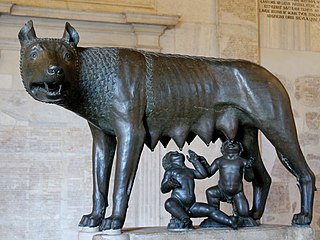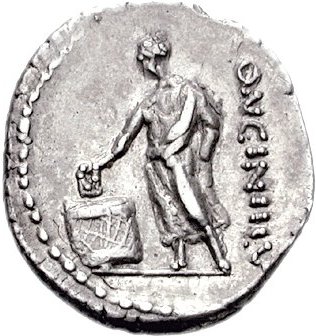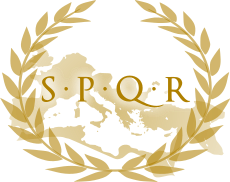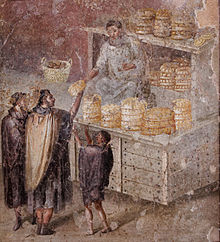
The cursus honorum was the sequential order of public offices held by aspiring politicians in the Roman Republic and the early Roman Empire. It was designed for men of senatorial rank. The cursus honorum comprised a mixture of military and political administration posts; the ultimate prize for winning election to each "rung" in the sequence was to become one of the two consuls in a given year.

The Roman Republic was the era of classical Roman civilization beginning with the overthrow of the Roman Kingdom and ending in 27 BC with the establishment of the Roman Empire. During this period, Rome's control expanded from the city's immediate surroundings to hegemony over the entire Mediterranean world.

Tribune was the title of various elected officials in ancient Rome. The two most important were the tribunes of the plebs and the military tribunes. For most of Roman history, a college of ten tribunes of the plebs acted as a check on the authority of the senate and the annual magistrates, holding the power of ius intercessionis to intervene on behalf of the plebeians, and veto unfavourable legislation. There were also military tribunes, who commanded portions of the Roman army, subordinate to higher magistrates, such as the consuls and praetors, promagistrates, and their legates. Various officers within the Roman army were also known as tribunes. The title was also used for several other positions and classes in the course of Roman history.
Marcus Furius Camillus is a semi-legendary Roman statesman and politician during the early Roman republic who is most famous for his capture of Veii and defence of Rome from Gallic sack after the Battle of the Allia. Modern scholars are dubious of Camillus' supposed exploits and believe many of them are wrongly attributed or otherwise wholly fictitious.

The decemviri or decemvirs refer to official 10-man commissions established by the Roman Republic.

The patricians were originally a group of ruling class families in ancient Rome. The distinction was highly significant in the Roman Kingdom and the early Republic, but its relevance waned after the Conflict of the Orders. By the time of the late Republic and Empire, membership in the patriciate was of only nominal significance. The social structure of ancient Rome revolved around the distinction between the patricians and the plebeians. The status of patricians gave them more political power than the plebeians, but the relationship between the groups eventually caused the Conflict of the Orders. This time period resulted in changing of the social structure of ancient Rome.

The Conflictof the Orders, sometimes referred to as the Struggle of the Orders, was a political struggle between the plebeians (commoners) and patricians (aristocrats) of the ancient Roman Republic lasting from 500 BC to 287 BC in which the plebeians sought political equality with the patricians. It played a major role in the development of the Constitution of the Roman Republic. Shortly after the founding of the Republic, this conflict led to a secession from Rome by the Plebeians to the Sacred Mount at a time of war. The result of this first secession was the creation of the office of plebeian tribune, and with it the first acquisition of real power by the plebeians.
The nobiles were members of a social rank in the Roman Republic indicating that one was "well known". This may have changed over time: in Cicero's time, one was notable if one descended from a person who had been elected consul. In earlier periods and more broadly, this may have included a larger group consisting of those who were patricians, were descended from patricians who had become plebeians via transitio ad plebem, or were descended from plebeians who had held curule offices.
Tribune of the plebs, tribune of the people or plebeian tribune was the first office of the Roman state that was open to the plebeians, and was, throughout the history of the Republic, the most important check on the power of the Roman Senate and magistrates. These tribunes had the power to convene and preside over the Concilium Plebis ; to summon the senate; to propose legislation; and to intervene on behalf of plebeians in legal matters; but the most significant power was to veto the actions of the consuls and other magistrates, thus protecting the interests of the plebeians as a class. The tribunes of the plebs were typically found seated on special benches set up for them in the Roman Forum. The tribunes were sacrosanct, meaning that any assault on their person was punishable by death. In imperial times, the powers of the tribunate were granted to the emperor as a matter of course, and the office itself lost its independence and most of its functions.

The Concilium Plebis was the principal assembly of the common people of the ancient Roman Republic. It functioned as a legislative/judicial assembly, through which the plebeians (commoners) could pass legislation, elect plebeian tribunes and plebeian aediles, and try judicial cases. The Plebeian Council was originally organized on the basis of the Curia but in 471 BC adopted an organizational system based on residential districts or tribes. The Plebeian Council usually met in the well of the Comitium and could only be convoked by the tribune of the plebs. The patricians were excluded from the Council.
The Licino-Sextian rogations were a series of laws proposed by tribunes of the plebs, Gaius Licinius Stolo and Lucius Sextius Lateranus, enacted around 367 BC. Livy calls them rogatio – though he does refer to them at times as lex – as the plebeian assembly did not at the time have the power to enact leges (laws).
Lucius Sextius Sextinus Lateranus was a Roman tribune of the plebs and is noted for having been one of two men who passed the Leges Liciniae Sextiae of 368 BC and 367 BC. Originally, these were a set of three laws. One law provided that the interest already paid on debts should be deducted from the principal and that the payment of the rest of the principal should be in three equal annual installments. Another one provided restricted individual ownership of public land in excess of 500 iugeras and forbade the grazing of more than 100 cattle on public land. The most important law provided that one of the two consuls be a plebeian. Having been reelected nine times, Lucius Sextius Lateranus and Gaius Licinius Stolo held the plebeian tribunate for ten years. In 368 BC the laws regarding debt and land were passed, but the law regarding the consulship was rejected. In 367 BC this law was passed. In the same year the two tribunes of the plebs proposed a fourth law concerning the priests who were the custodians of the sacred Sibylline Books, and Lucius Sextius Lateranus was elected to serve as consul for the year 366 BC. Livy wrote that he was "the first of the plebeians to attain that honour."
Secessio plebis was an informal exercise of power by Rome's plebeian citizens between the 5th century BC and 3rd century BC., similar in concept to the general strike. During the secessio plebis, the plebs would abandon the city en masse in a protest emigration and leave the patrician order to themselves. Therefore, a secessio meant that all shops and workshops would shut down and commercial transactions would largely cease. This was an effective strategy in the Conflict of the Orders due to strength in numbers; plebeian citizens made up the vast majority of Rome's populace and produced most of its food and resources, while a patrician citizen was a member of the minority upper class, the equivalent of the landed gentry of later times. Authors report different numbers for how many secessions there were. M. Cary and H. H. Scullard state there were five between 494 BC and 287 BC.

Social class in ancient Rome was hierarchical, with multiple and overlapping social hierarchies. An individual's relative position in one might be higher or lower than in another, which complicated the social composition of Rome.

The crisis of the Roman Republic was an extended period of political instability and social unrest from about 134 BC to 44 BC that culminated in the demise of the Roman Republic and the advent of the Roman Empire.

A tribus, or tribe, was a division of the Roman people for military, censorial, and voting purposes. When constituted in the comitia tributa, the tribes were the voting units of a legislative assembly of the Roman Republic.

The constitution of the Roman Republic was a set of uncodified norms and customs which, together with various written laws, guided the procedural governance of the Roman Republic. The constitution emerged from that of the Roman kingdom, evolved substantively and significantly—almost to the point of unrecognisability—over the almost five hundred years of the republic. The collapse of republican government and norms beginning in 133 BC would lead to the rise of Augustus and his principate.

The Tribal Assembly was an assembly consisting of all Roman citizens convened by tribes (tribus).

The Aventine Triad is a modern term for the joint cult of the Roman deities Ceres, Liber and Libera. The cult was established c. 493 BC within a sacred district (templum) on or near the Aventine Hill, traditionally associated with the Roman plebs. Later accounts describe the temple building and rites as "Greek" in style. Some modern historians describe the Aventine Triad as a plebeian parallel and self-conscious antithesis to the Archaic Triad of Jupiter, Mars and Quirinus and the later Capitoline Triad of Jupiter, Minerva and Juno. The Aventine Triad, temple and associated ludi served as a focus of plebeian identity, sometimes in opposition to Rome's original ruling elite, the patricians.

The Servian constitution was one of the earliest forms of military and political organization used during The Roman Republic. Most of the reforms extended voting rights to certain groups, in particular to Rome's citizen-commoners who were minor landholders or otherwise landless citizens hitherto disqualified from voting by ancestry, status or ethnicity, as distinguished from the hereditary patricians. The reforms thus redefined the fiscal and military obligations of all Roman citizens. The constitution introduced two elements into the Roman system of government: a census of every male citizen, in order to establish his wealth, tax liabilities, military obligation, and the weight of his vote; and the comitia centuriata, an assembly with electoral, legislative and judicial powers. Both institutions were foundational for Roman republicanism.









